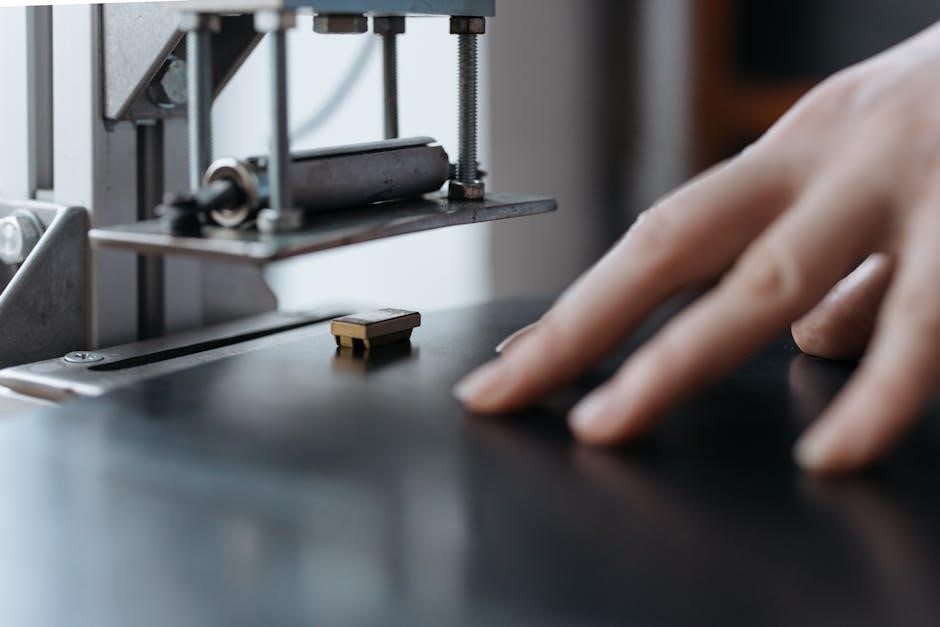A jigsaw guide rail is a tool designed to enhance precision and control during cutting tasks, ensuring straighter, more accurate cuts in various materials like wood or metal.
1.1 What is a Jigsaw Guide Rail?
A jigsaw guide rail is an accessory designed to enhance the accuracy and stability of jigsaw cuts. It attaches to the jigsaw, providing a straightedge or template to follow, ensuring precise, consistent cuts. This tool is particularly useful for straight or angled cuts in various materials, such as wood, metal, or plastic. By guiding the jigsaw along a predefined path, it minimizes errors and improves the quality of the cut, making it essential for woodworking, metalworking, and DIY projects.
1.2 Importance of Guide Rails in Jigsaw Operations
Guide rails are crucial for achieving precision and accuracy in jigsaw operations. They help maintain straight or angled cuts, reducing human error and ensuring consistent results. By providing a stable path for the jigsaw, guide rails enhance control, especially in intricate or repetitive tasks. This makes them indispensable for professionals and DIYers alike, improving both efficiency and safety. Their use ensures cleaner cuts and minimizes material waste, making them a vital tool for woodworking, metalworking, and other precision-cutting projects.
1.3 Brief History and Evolution of Jigsaw Guide Rails
The concept of guide rails for jigsaws emerged in the early 20th century, initially as simple metal strips to aid in straight cuts. Over time, advancements in materials and design led to adjustable and precision-engineered rails. Modern guide rails incorporate features like laser alignment and magnetic attachments, enhancing accuracy and versatility. This evolution reflects the growing demand for precision tools in woodworking and metalworking, making guide rails an essential accessory for achieving professional-grade results in various cutting applications.

Types of Jigsaw Guide Rails
Jigsaw guide rails are categorized into fixed, adjustable, laser, and magnetic types, each tailored for different cutting requirements and material compatibility.
2.1 Fixed Guide Rails
Fixed guide rails are rigid, non-adjustable attachments designed to provide consistent cutting paths for jigsaws. They are typically made of durable materials like aluminum or steel, ensuring stability. These rails are ideal for straight cuts in wood, metal, or plastic, offering enhanced precision and control. Unlike adjustable rails, they do not allow for variable widths, making them best suited for projects requiring repetitive, uniform cuts. Their simplicity and reliability make them a popular choice for both professionals and DIY enthusiasts alike.
2.2 Adjustable Guide Rails
Adjustable guide rails offer versatility by allowing users to customize the cutting path according to specific project needs. These rails can be set to varying widths, accommodating different materials and tasks. Made from durable materials like aluminum or steel, they provide flexibility while maintaining precision. Their adaptability makes them ideal for intricate or varied cutting requirements, catering to both professionals and DIY enthusiasts seeking accuracy and ease of use in diverse applications.
2.3 Laser Guide Rails
Laser guide rails integrate advanced technology to project a precise laser line, guiding the jigsaw along the desired cutting path. This feature enhances accuracy, especially for intricate cuts, and is ideal for professionals and DIY enthusiasts. The laser’s brightness can often be adjusted for visibility in various lighting conditions. Alignment is simplified, reducing errors and ensuring straight, consistent cuts. This modern tool is particularly useful for complex projects requiring high precision, offering a reliable solution for achieving professional-grade results with minimal effort.
2.4 Magnetic Guide Rails
Magnetic guide rails utilize strong magnetic forces to attach securely to metal surfaces, providing stability and precision during cuts. This type is particularly useful for metalworking, as it holds the rail firmly in place without additional clamping. The magnetic feature ensures minimal movement, allowing for smooth, accurate cuts. They are ideal for straight edges and consistent results, making them a popular choice among professionals and hobbyists working with metallic materials. Their ease of use and reliability enhance productivity in various projects.

Materials Used for Jigsaw Guide Rails
Jigsaw guide rails are crafted from durable materials like aluminum, steel, plastic, and composites, each offering unique benefits for precision, strength, and versatility in cutting applications.
3.1 Aluminum Guide Rails
Aluminum guide rails are lightweight, durable, and corrosion-resistant, making them ideal for precise cutting tasks. Their smooth surface ensures consistent performance across various materials. They are widely used in woodworking and metalworking due to their ability to maintain accuracy and reduce friction. Aluminum rails are also easy to clean and maintain, ensuring long-term reliability. Their versatility and strength make them a popular choice among professionals and DIY enthusiasts for achieving clean, professional-grade cuts with ease.
3.2 Steel Guide Rails
Steel guide rails are renowned for their exceptional durability and strength, making them ideal for heavy-duty cutting tasks. They offer superior rigidity and resistance to wear and tear, ensuring consistent performance over time. Often coated to prevent rust, steel rails are perfect for industrial applications and cutting through tough materials like thick metal or hardwood. Their robust construction ensures minimal flex, providing precise cuts. Proper alignment with the jigsaw is essential for optimal results. Regular maintenance, such as cleaning and lubricating, helps extend their lifespan and maintain accuracy.
3.3 Plastic Guide Rails
Plastic guide rails are lightweight, durable, and corrosion-resistant, making them ideal for lighter cutting tasks. They are often used in DIY projects and small workshops due to their portability and ease of setup. Plastic rails are versatile and can be used with various materials, including wood and thin metal. They are also cost-effective and easy to clean, ensuring long-term performance. While they may lack the rigidity of metal rails, they are perfect for applications where weight and flexibility are key advantages for precise cuts and smooth operations.
3.4 Composite Guide Rails
Composite guide rails combine materials like fiber-reinforced polymers and metals for enhanced durability and resistance to wear. They offer a balance between strength and weight, making them suitable for demanding projects. Composite rails are less prone to vibration and provide smooth, precise cuts. Their versatility allows them to be used with various materials, including wood, metal, and plastics. While more expensive than plastic rails, composites deliver long-lasting performance and maintain accuracy over time, making them a popular choice for professionals and serious DIY enthusiasts seeking reliable results in their cutting tasks.

Installation and Setup of Jigsaw Guide Rails
Proper installation and setup of jigsaw guide rails ensure precise cuts. Align the rail with the tool’s base, secure it firmly, and calibrate for accuracy. Use a ruler or gauge to verify alignment. Ensure the rail is level and tightened evenly to prevent wobbling. Refer to the manufacturer’s instructions for specific mounting requirements. A well-set guide rail enhances cutting efficiency and reduces errors, making it essential for achieving professional-grade results in woodworking or metalwork projects.
4.1 Step-by-Step Installation Guide
Begin by attaching the guide rail to the jigsaw’s base using the provided screws. Ensure the rail is aligned with the blade, using a ruler for accuracy. Tighten the screws firmly but avoid over-tightening, which may restrict movement. Next, calibrate the rail by making a test cut on scrap material. Adjust the alignment if necessary for straight cuts. Finally, secure the rail with clamps or adhesive strips for stability during use. Proper installation ensures precise cuts and enhances tool performance.
4.2 Aligning the Guide Rail with the Jigsaw
To align the guide rail with your jigsaw, start by loosening the mounting screws on the rail. Position the rail so it is parallel to the cutting edge of the blade. Use a ruler or straightedge to ensure proper alignment. Once aligned, tighten the screws firmly to secure the rail in place. Double-check the alignment by making a test cut on scrap material. Adjust the rail’s position if necessary for precise, accurate cuts. Proper alignment is crucial for smooth, consistent operation.
4.3 Calibrating the Guide Rail for Accuracy
Calibrating the guide rail ensures precise cuts by aligning it with the jigsaw blade. Start by attaching the rail to the tool and loosening any locking mechanisms. Use a combination square or calipers to verify the rail’s parallelism with the blade. Make fine adjustments as needed, then tighten the locking mechanisms securely. Finally, test the setup by cutting a straight line through scrap material to confirm accuracy. Regular calibration is essential for maintaining consistent results and preventing misalignment during cutting tasks.

Maintenance and Care of Jigsaw Guide Rails
Regular cleaning and lubrication of moving parts ensure smooth operation. Store the guide rail in a dry, protected area to prevent rust and damage, extending its lifespan.
5.1 Cleaning the Guide Rail
Cleaning the guide rail is essential for maintaining accuracy and preventing debris buildup. Use a soft, dry cloth to wipe away dust and sawdust regularly. For tougher residue, dampen the cloth slightly but avoid harsh chemicals. Compressed air can be used to clear tight spaces. After cleaning, ensure the rail is completely dry to prevent rust. Regular cleaning ensures smooth operation and extends the lifespan of the guide rail.
- Use a soft cloth to avoid scratching the surface.
- Avoid harsh chemicals that may damage the material.
- Inspect and clean after each use for optimal performance.
5.2 Lubricating Moving Parts
Lubricating the moving parts of your jigsaw guide rail is crucial for smooth operation and longevity. Use a silicone-based spray or light machine oil to reduce friction and wear. Apply a small amount to the sliding components and let it sit for a few minutes before wiping off excess with a clean cloth. Avoid over-lubrication, as it can attract dust and debris. Regular lubrication ensures the guide rail moves effortlessly, maintaining precision and consistency in your cuts.
- Use silicone-based sprays or light machine oils.
- Apply sparingly to avoid attracting dust.
- Wipe off excess to prevent buildup.
5.3 Storing the Guide Rail Properly
Proper storage of your jigsaw guide rail is essential to maintain its accuracy and prevent damage. Store it in a protective case or sleeve to avoid scratches and bends. Ensure the rail is clean and dry before storage to prevent rust or corrosion. Keep it in a cool, dry place away from direct sunlight and extreme temperatures. Avoid stacking heavy tools on top of the guide rail to prevent warping or misalignment. Always handle the rail with care to maintain its integrity.
- Use a protective case or sleeve.
- Keep it clean and dry.
- Store in a cool, dry environment.
- Avoid stacking heavy tools on top.

Safety Precautions When Using Jigsaw Guide Rails
Always ensure proper alignment and secure the guide rail before cutting to avoid accidents. Wear protective eyewear and keep loose clothing tied back while operating the jigsaw.
- Avoid overheating the tool by taking regular breaks.
- Prevent accidental cuts by keeping hands away from the blade path.
6.1 Ensuring Proper Alignment
Proper alignment of the jigsaw guide rail is critical for accurate cuts and safety. Misalignment can lead to uneven cuts or damage to the tool. Always double-check the rail’s position relative to the workpiece and ensure it is securely fastened. Use the jigsaw’s built-in alignment features or external guides to maintain consistency. Regularly calibrate the guide rail to prevent drift, especially after extended use. Proper alignment ensures smooth operation and reduces the risk of accidents during cutting tasks;
- Use a straightedge or laser guide for precise setup.
- Tighten all screws firmly to prevent movement during use.
6.2 Avoiding Overheating
Overheating can damage both the jigsaw and the guide rail, reducing their lifespan. To prevent this, ensure proper airflow around the tool and avoid continuous operation without breaks. Keep the workpiece clean to minimize friction, which generates heat. Use the jigsaw’s built-in cooling features, such as a chip blower, to clear debris and maintain optimal performance. Regular maintenance, like cleaning and lubricating moving parts, also helps reduce heat buildup during use.
- Take regular breaks during prolonged cutting tasks.
- Ensure the guide rail is free from dust and debris.
6.3 Preventing Accidental Cuts
To prevent accidental cuts, always ensure the guide rail is securely attached to the jigsaw and properly aligned with the workpiece. Use protective gear like gloves and safety goggles. Keep loose clothing or long hair tied back to avoid interference. Maintain a firm grip on the jigsaw and avoid overreaching. Ensure the workpiece is clamped or held firmly in place before starting the cut. Never leave the jigsaw unattended while it is in operation.
- Double-check the guide rail alignment before cutting.
- Keep children and pets away from the workspace.

DIY Projects Using Jigsaw Guide Rails
Jigsaw guide rails enable precise cuts for various DIY projects, such as crafting custom furniture, creating intricate wood designs, and shaping metal art with accuracy and ease.
7.1 Building Custom Furniture
Jigsaw guide rails are invaluable for building custom furniture, enabling precise, smooth cuts in wood or metal. They allow for intricate designs and curved edges, ensuring professional-grade results. By maintaining consistent accuracy, guide rails help craftsmen achieve perfectly aligned joints and seamless finishes. This tool is particularly useful for creating complex shapes, such as rounded table legs or decorative panels, making it easier to bring unique furniture designs to life with minimal effort and maximum precision.
7.2 Creating Intricate Wood Designs
Jigsaw guide rails are essential for crafting intricate wood designs, offering unparalleled precision and control. They enable smooth, curved cuts and complex shapes, perfect for scrollwork, lattice patterns, or decorative inlays. By maintaining consistent alignment, guide rails help avoid mistakes, ensuring clean, professional results. This tool is particularly useful for creating detailed wood carvings, allowing artisans to bring intricate designs to life with ease and accuracy, making it a must-have for woodworking projects that require finesse and attention to detail.
7.3 Crafting Metal Art Pieces
Jigsaw guide rails are invaluable for crafting intricate metal art, enabling precise and controlled cuts. They allow for smooth navigation through complex metal shapes, ensuring accuracy and minimizing errors. The guide rail’s stability is crucial for cutting thin metal sheets or curved designs without warping. This tool is perfect for creating decorative metal sculptures, intricate patterns, or custom frameworks. With a guide rail, artisans can achieve professional-grade metalwork, making it an essential asset for both experienced metal artists and DIY enthusiasts exploring metal crafting projects.

Troubleshooting Common Issues
Common issues with jigsaw guide rails include misalignment, wobbling, or damage. Regular calibration, proper storage, and timely repairs can resolve these problems, ensuring optimal performance.
8;1 Misalignment of the Guide Rail
Misalignment of the guide rail is a common issue that can lead to inaccurate cuts. This often occurs due to improper installation or uneven surfaces. To fix this, ensure the rail is securely attached and aligned with the jigsaw’s base. Double-check the setup on a flat surface and adjust screws if necessary. Regular calibration and thorough cleaning can prevent misalignment, ensuring precise cuts and extending the tool’s lifespan. Proper alignment is crucial for achieving professional results in woodworking or metalworking projects.
8.2 Wobbling or Vibration
Wobbling or vibration of the guide rail can occur due to improper installation or loose screws. This issue often leads to uneven cuts and reduced precision. To address it, ensure the guide rail is firmly secured to the work surface and aligned with the jigsaw. Regularly check for wear and tear, and tighten any loose connections. Using a rubber mallet to gently tap the rail into place can also help stabilize it. Proper setup and maintenance are key to minimizing vibration and ensuring smooth operation. Always refer to the manufacturer’s guidelines for optimal performance.
8.3 Damage to the Guide Rail
Damage to the guide rail can occur from heavy use, mishandling, or accidental drops. Inspect the rail regularly for dents, bends, or wear. If damaged, replace it immediately to maintain accuracy. Avoid using excessive force, as this can warp the rail. Store the guide rail in a protective case when not in use to prevent accidental damage. Regular cleaning and proper alignment also help extend its lifespan and ensure optimal performance during cutting tasks. Always handle the rail with care to prevent costly repairs or replacements.

Advanced Techniques with Jigsaw Guide Rails
Advanced techniques with jigsaw guide rails include mastering curved cuts, achieving precise beveled edges, and creating flawless precision joints. These methods require skill and practice to ensure accuracy and consistency in cutting various materials. By leveraging the guide rail’s alignment features, users can accomplish complex cuts with ease, enhancing their woodworking or metalworking projects. These techniques showcase the versatility and efficiency of jigsaw guide rails in demanding applications.
9.1 Curved Cuts
Curved cuts with a jigsaw guide rail require precise control and the right technique. Start by setting the rail along the desired curve, ensuring alignment. Use a fine-tooth blade for smooth edges. Maintain steady pressure, allowing the saw to glide naturally. For tight curves, make small, gradual adjustments. Practice on scrap material to master the flow. This method ensures accurate, professional-looking curved cuts, ideal for intricate designs in woodworking or metalwork projects, enhancing creativity and precision in your craftsmanship.
9.2 Beveled Cuts
Beveled cuts with a jigsaw guide rail involve creating angled cuts for joints or decorative edges. Set the rail to the desired angle and secure it firmly. Use a high-tooth blade for smooth results. Apply steady, consistent pressure, maintaining the angle throughout the cut. This technique ensures precise, professional-looking bevels. It’s ideal for woodworking and metalwork, offering versatility in creating angled finishes. Proper alignment and controlled movement are key to achieving accurate, clean beveled cuts with your jigsaw guide rail.
9.3 Precision Joints
Precision joints require exact alignment and smooth cuts, making jigsaw guide rails indispensable. Use a fine-tooth blade for clean edges and clamp the rail firmly to prevent movement. Measure and mark the material accurately, then follow the rail’s guidance for straight, precise cuts. This technique is ideal for woodworking and metalwork, ensuring joints fit seamlessly. Proper setup and blade selection are crucial for achieving professional-quality results. Precision joints enhance both functionality and aesthetics in your projects, making them durable and visually appealing.
Comparison with Other Cutting Guides
Jigsaw guide rails offer unique versatility compared to circular saw or miter saw guides, excelling in curved cuts and portability, while routers provide more precision for intricate designs.
10.1 Jigsaw Guide Rails vs. Circular Saw Guides
Jigsaw guide rails are ideal for curved and intricate cuts, offering portability and versatility. In contrast, circular saw guides excel at straight, long cuts in heavy materials like thick wood or metal. While circular saws are more powerful, jigsaw guide rails provide better agility for detailed work. Both tools serve unique purposes, with jigsaw guides being preferred for precision in complex shapes and circular saw guides for large-scale, straight-edge projects. Choosing the right guide depends on the specific cutting requirements and material type.
10.2 Jigsaw Guide Rails vs. Miter Saw Guides
Jigsaw guide rails are designed for precise, curved, and intricate cuts, offering versatility across various materials. Miter saw guides, however, specialize in making accurate angled cuts, ideal for trim work and framing. Jigsaw guides are more portable and adaptable, while miter saw guides are typically stationary and better suited for repetitive, straight-edge cuts. Both tools cater to different needs, with jigsaw guides excelling in complex cuts and miter saw guides in precise angles, making them complementary in a workshop setup.
10.3 Jigsaw Guide Rails vs. Router Guides
Jigsaw guide rails are designed for precise, curved, and intricate cuts, while router guides are primarily used for edge profiling and decorative cuts; Jigsaw guides offer more portability and adaptability, excelling in freehand and complex cuts, whereas router guides are typically stationary and better suited for consistent edge work. Both tools serve distinct purposes, with jigsaw guides ideal for versatility and router guides perfect for detailed edge finishes, making them complementary in a workshop for diverse woodworking tasks.

Future Trends in Jigsaw Guide Rail Technology
Future trends include smart guide rails with sensors for real-time feedback, automated alignment systems, and integration with CNC machines for enhanced precision and efficiency in cutting tasks.
11.1 Smart Guide Rails with Sensors
Smart guide rails with sensors represent a cutting-edge advancement in jigsaw technology. These rails are equipped with advanced sensors that provide real-time feedback, ensuring precise cuts and optimal material utilization. They can detect the thickness of the material, track the cutting path, and even adjust for uneven surfaces. This technology minimizes errors and enhances efficiency, making complex cuts more accessible. Sensors also enable automated corrections, reducing the need for manual adjustments and improving overall accuracy. This innovation is set to revolutionize DIY projects and professional woodworking alike.
11.2 Automated Alignment Systems
Automated alignment systems integrate advanced software and sensors to self-adjust the guide rail, ensuring perfect alignment with the workpiece. These systems eliminate manual adjustments, reducing setup time and human error. They are particularly useful for intricate cuts and repetitive tasks, offering unmatched precision. Professionals and DIYers benefit from faster workflows and consistent results. This technology streamlines the cutting process, making it more efficient and accessible for projects requiring high accuracy and repeatability. It represents a significant leap forward in jigsaw guide rail functionality.
11.3 Integration with CNC Machines
Integrating jigsaw guide rails with CNC machines enhances precision and automation in cutting processes. This combination enables complex cuts with high accuracy, leveraging CNC’s programmable control. It streamlines workflows, reducing manual intervention and boosting productivity. The system is scalable, catering to both small-scale DIY projects and large industrial applications. By merging traditional tools with advanced CNC technology, users achieve consistent results and expand creative possibilities. This integration is a significant advancement in modern machining, making cutting tasks more precise and efficient than ever before.
Jigsaw guide rails have revolutionized cutting precision, offering versatility for wood and metal. Integration with advanced tech enhances efficiency, driving the future innovation in woodworking and metalworking industries.
12.1 Summary of Key Points
Jigsaw guide rails are essential tools for achieving precision and versatility in cutting tasks. They enhance accuracy, reduce errors, and simplify complex cuts. Available in various types like fixed, adjustable, and magnetic, they cater to different project needs. Proper installation, alignment, and calibration ensure optimal performance. Regular maintenance, including cleaning and lubrication, prolongs their durability. Safety precautions, such as avoiding overheating and ensuring proper alignment, are crucial for safe operation. These guide rails are indispensable for DIY projects, woodworking, and metalworking, offering unmatched control and efficiency for craftsmen and hobbyists alike.
12.2 Final Thoughts on Jigsaw Guide Rails
Jigsaw guide rails are indispensable tools for any workshop or project, offering precision, versatility, and ease of use. Whether for straight cuts, curves, or intricate designs, they provide unmatched control. Their adaptability to various materials and tasks makes them essential for professionals and hobbyists alike. By enhancing accuracy and reducing waste, guide rails streamline workflows and elevate craftsmanship. Their durability and ease of maintenance further solidify their place as a must-have accessory for achieving professional-grade results in woodworking and beyond.
12.3 Encouragement to Explore Further
Exploring the full potential of jigsaw guide rails opens up endless possibilities for creativity and precision. Dive into advanced techniques, experiment with various materials, and uncover new ways to enhance your projects. The journey of mastering guide rails is both rewarding and educational, allowing you to push the boundaries of what’s possible. Embrace the evolution of these tools and stay curious about their capabilities. Your next project could be your most impressive yet—so keep exploring, learning, and creating!












































